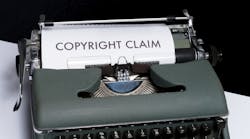It seems, in almost every instance, the internet has the perfect image. Whether you’re looking for a product logo to use for a promotional poster or an OEM photo to help a social media post, a quick search online can pull up the exact content you were looking for.
Despite that easy access, though, most every creative work available to download online is protected by copyright law, and reposting, disseminating or otherwise sharing that intellectual property without consent from the owner of that work could land you and your shop in some deep legal trouble.
Regardless of where a work is posted and in what context—on your website for a promotion, on your social media pages to garner interest in a new product or event or even on a physical print-out for your store or for mail marketing—using an image or other work without permission is grounds for a lawsuit from the content’s creator.
Mark Anfinson, a Minneapolis-based communications lawyer specializing in First Amendment and copyright law, says far too often he’s seen a small business unintentionally infringe on a copyright by publishing an image in their store or sharing a video with a copyrighted song playing under it and have to pay for it.
“[Copyright infringement] lawsuits are often filed against small businesses because it’s usually the small businesses that don’t have an appreciation for copyright law, so they innocently pick up these...images thinking they’re OK,” Anfinson says. “One of the cruel realities of copyright is there is no such thing as innocent infringement.”
Having even a basic understanding of what copyright is and what it protects can help save your shop a lot of time, headaches and money by shutting down lawsuits before they even happen.
Protected Under Law
The concept of modern copyright was established in Article I Section 8 of the U.S. Constitution, which secured “authors and inventors the exclusive right to their respective writings and discoveries.”
In the sixth edition of his Communications Law textbook, John Zelezny says copyright is granted to “original works of authorship, fixed in any tangible medium of expression” and is created as soon as those works come into existence; no formal registration or other filing is necessary for an image, song, logo or any other type of intellectual property to gain protection under the law, and no official copyright notice has to be placed on a work for it to gain protection.
“That’s one thing that will often trip people up when they’re looking for imagery on the web,” Anfinson says. “They’ll look at something and say ‘oh, it doesn’t have the copyright image on it, so it must be okay for me to use it.’ That’s absolutely not true. Copyright protection applies whether or not a notice is on the work. It’s automatic.”
When searching for images to use for a website or social media page online, it’s best to assume that anything found is subject to copyright. Even logos from manufacturers, suppliers or shop partners are protected under copyright law and cannot be used without permission.
“Without Express Written Consent”
Copyright infringement, simply put, is stealing. Because of that, Anfinson says, anyone who commits infringement can be subject to lawsuits and other “serious penalties” for doing so.
“It’s bad to steal people’s stuff, but it’s a lot worse to be hit with a lawsuit,” Anfinson says. “You’re going to pay at least $5,000, maybe a little less if you’re lucky, to get away from this thing and a lot more if you get sued.”
The infringement doesn’t even have to be intentional. Without express written consent from an author or creator, use of their work is not allowed. Even using images from an automotive manufacturer’s website or provider logos without their direct permission is grounds for a suit.
“Even if you have no possibility of knowing that what you used is copyrighted, even if you’ve been told by some third party that it’s okay to use it, it doesn’t help you one bit,” Anfinson says. “If you use it and it’s not authorized, you are as culpable and liable as anyone else in this situation.”
Even a “minor infringement,” such as only using an image once, can be grounds for legal action. Copyright holders don’t have to provide any sort of notice or takedown request before they have a legal claim to file a lawsuit.
Royalty-Free Image Websites
—
Shutter Stock
Adobe Stock
Pexels
Negative Space
Pixaby
Burst
Reshot
Order Outside the Court
Most copyright infringement suits, once filed, will never see a courtroom.
Over the past decade, Anfinson has seen what he describes as the rise in prevalence of a subgroup of lawyers, known as copyright trolls, who scour the internet on behalf of their clients specifically looking for cases, intentional or otherwise, of copyright infringement.
Most cases of infringement are usually filed against small businesses because they aren’t as intimately familiar with copyright laws.
Once a copyright troll finds a case of infringement, they’ll send a letter to the small business demanding some amount of payment—Anfinson says is common for those demands to fall somewhere between $5,000 and $20,000—or threatening legal action.
“For the vast majority of smaller businesses...it’s almost always going to settle because the logic of settlement is so compelling, but that doesn’t mean it’s pleasant or easy.”
In many cases, Anfinson says once a shop owner or manager realizes they have indeed committed copyright infringement, they’re left with no choice but to either settle the suit out of court or to take a chance in the courtroom—a chance that is almost never in favor of the defendant, Anfinson says.
“For the vast majority of smaller businesses...it’s almost always going to settle because the logic of settlement is so compelling, but that doesn’t mean it’s pleasant or easy,” he says. “When you get sued, it’s not at all uncommon that you’re going to incur costs anywhere between $25,000 and $100,000 between the legal fees and the settlement. No small business wants to incur that and, in some cases, can even afford that.”
An Ounce of Prevention
The best course of action in copyright infringement cases is to not infringe someone’s copyright in the first place.
“It’s easily avoided if you follow the rule to not use any illustration, graph, photo, musical material unless you know for certain that it’s not subject to copyright,” Anfinson says.
If there is an image or other piece of intellectual property that a shop wants to use, Anfinson says it’s technically possible to use file metadata to find and contact an original author, but more often than not putting the time, effort and resources into doing so is never worth it.
Instead, creating your own works such as photos, graphs or other illustrations, hiring someone else to produce a work for you or finding content on a reputable Creative Commons website that produces copyright-free works are all good ways to find works to promote your shop. Working with your suppliers and getting explicit consent to use their logos and images is also an effective way to get high-quality images and graphs of products without risking potential infringement.
As long as a shop and its staff are actively aware of how pervasive copyright protection is and take steps to avoid infringement will save themselves a lot of hassle in the long run.
“Because of the nature of the internet, where any use of someone’s (intellectual property) can be detected quickly, there’s no place to hide,” Anfinson says, “so if you do it, you’re almost certainly going to get caught. You’ve got to be really careful. An ounce of prevention is worth a pound of cure.”





